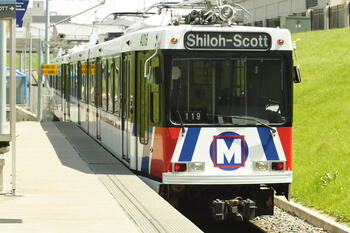
The future of public transit is nearly empty buses and railcars. Yet President Biden’s American Jobs Plan calls for spending $85 billion on transit. Although transit carries less than 1 percent of passenger travel in the United States, and no freight, this represents 28 percent of the funds Biden proposes to spend on transportation.
Click here to download a copy of the policy brief.
Considering that the pandemic has cut transit ridership by more than half, while driving has recovered to 97 percent of pre-pandemic levels, this a poor, and poorly timed, use of public funds. Biden’s plan claims that spending more on transit “will ultimately reduce traffic congestion for everyone.” Other transit advocates claim that it will help low-income people as well as reduce greenhouse gas emissions. But none of these claims are true.
Third-Class Transportation
Transit is fundamentally inferior to the alternatives.
- It’s slow: According to the American Public Transportation Association, transit averages 15 miles per hour, while driving in many American cities averages 30 miles per hour or more.
- It’s inconvenient: While people can drive door-to-door on their own schedules, transit riders are limited to traveling on transit agency timetables and must usually first walk or drive to a transit stop, then walk to their final destination.
- It’s expensive: Counting subsidies to both highways and transit, American transit agencies spend more than five times as much moving people per passenger mile as Americans spend driving their cars.
- It doesn’t reach many jobs: The University of Minnesota’s Accessibility Observatory estimates that a typical resident of the nation’s 50 largest urban areas can reach more than twice as many jobs in a 20-minute auto drive than a 60-minute transit ride. Auto users can reach 12 times as many jobs in 60 minutes up to 67 times as many jobs in 10 minutes as transit users.
- Transit can’t even compete with bicycles: The Accessibility Observatory also calculates that people can reach more jobs in bike rides of 50 minutes or less than in same time spent on transit.
- Spending more money on transit doesn’t solve the problem: The New York urban area has by far the best transit system in America and one of the best in the world, yet residents can still reach four times as many jobs in 60 minutes and 12 times as many in 10 minutes by car as by transit and can reach more jobs by bicycle than by transit on trips of 30 minutes or less.
In 2019, nearly 96 percent of working Americans lived in a household with at least one motor vehicle. Of the 4.3 percent who did not, most didn’t take transit to work. We should be happy that fewer people have to depend on third-class transportation.
Read the rest of this piece at The Antiplanner.
Randal O’Toole, the Antiplanner, is a policy analyst with nearly 50 years of experience reviewing transportation and land-use plans and the author of The Best-Laid Plans: How Government Planning Harms Your Quality of Life, Your Pocketbook, and Your Future.
Photo: Matthew Black, via Flickr under CC 2.0 License.












